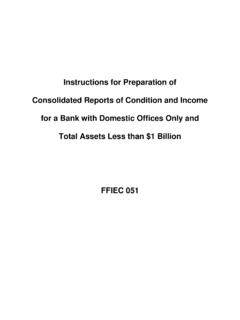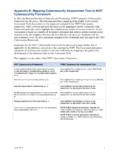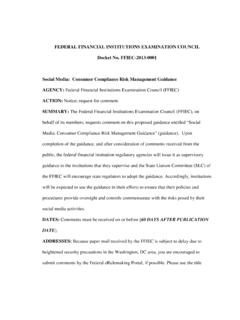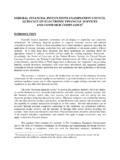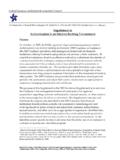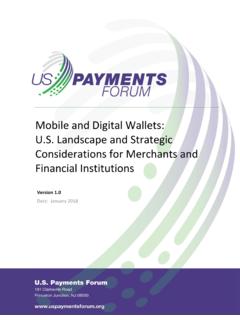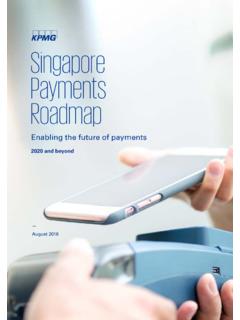Transcription of Appendix E: Mobile Financial Services - FFIEC Home Page
1 FFIEC IT Examination Handbook Appendix E: Mobile Financial Services Appendix E: Mobile Financial Services Introduction Mobile Financial Services (MFS) are the products and Services that a Financial institution provides to its customers through Mobile The Mobile channel2 provides an opportunity for Financial institutions of all sizes to increase customer access to Financial Services and decrease costs. Although the risks from traditional delivery channels for Financial Services continue to apply to MFS, the risk management strategies may differ. As with other technology- related risks, management should identify, measure, mitigate, and monitor the risks involved and be familiar with technologies that enable MFS. Purpose and Scope This Appendix focuses on risks associated with MFS and emphasizes an enterprise-wide risk management approach to the effective management and mitigation of those risks.
2 This Appendix also discusses the technologies used in the Mobile channel and may be helpful to the board and management for the integration of MFS into the institution's risk management program. The risks and controls addressed in this Appendix , however, are not exhaustive. Additionally, this Appendix contains a set of work program objectives to help the examiner determine the inherent risk and adequacy of controls at an institution or third party providing MFS. Background MFS involve the use of a Mobile device to conduct banking transactions and to initiate retail payments. Customers' Mobile transactions often emulate those initiated on traditional desktop computers; however, MFS can provide more convenient transaction execution capabilities, such as the initiation or acceptance of Mobile payments. MFS can pose elevated risks related to device security, authentication, data security, application security, data transmission security, compliance, and third-party management.
3 Customers are often less likely to activate security controls, virus protection, or personal firewall functionality on their Mobile devices, and MFS. often involve the use of third-party service providers. This Appendix addresses the following: MFS technologies. Risk identification. Risk measurement. Risk mitigation. Monitoring and reporting. 1. A Mobile device is a portable computing and communications device with information-storage capability. 2. The Mobile channel refers to providing banking and other Financial Services through Mobile devices. April 2016 1. FFIEC IT Examination Handbook Appendix E: Mobile Financial Services Mobile Financial Services Technologies Financial institutions implement and offer MFS through technologies such as the following: Short message service (SMS)/text messaging. Mobile -enabled Web sites and browsers. Mobile applications. Wireless payment technologies. Short Message Service SMS is a text messaging service component of phone, Web, or Mobile communication systems.
4 SMS uses standardized communications protocols to allow devices to exchange short text messages. Messages are typically limited to 160 characters and communicate either between Mobile devices or between businesses and Mobile devices ( , Financial institutions requesting customer verification of transactions). Within the context of MFS, a customer uses SMS to provide Financial transaction instructions to their Financial institution. Financial institutions use SMS to provide information to customers, including account alerts or to communicate one-time passwords for Web site authentication. Mobile -Enabled Web Sites A Mobile device's browser allows customers to access a Financial institution's Web site. Many Financial institutions provide Mobile -enabled Web sites, in addition to their regular Web site, which may improve the customer experience. The Mobile -enabled Web site is designed to detect the type of device the customer is using ( , Mobile device or desktop computer) and displays Web pages in the best format for that device.
5 Mobile Applications Mobile applications are downloadable software applications developed specifically for use on Mobile devices. Mobile Financial applications are developed by or for Financial institutions to allow customers to perform account inquiries, retrieve information, or initiate Financial transactions. This technology leverages features and functions unique to each type of Mobile device and often provides a more user-friendly interface than is possible or available with either SMS or Web-based Mobile banking. Wireless Payment Technologies Customers may use Mobile technologies to initiate wireless payments at point-of-sale (POS). terminals, make person-to-person (P2P) payments, or make other types of wireless payments, such as parking meter and mass transit access payments. Mobile wallets3 allow customers to make wireless payments with a virtual payment card, as opposed to a physical card.
6 The 3. A Mobile wallet is a front-end application that stores payment card information on the Mobile device and allows payments to be made using a Mobile device. The Mobile wallet utilizes traditional retail payment channels such as ACH, EFT, and debit/credit card networks to process the payments. April 2016 2. FFIEC IT Examination Handbook Appendix E: Mobile Financial Services exchange of payment credentials and authorization between the Mobile device and the payment recipient can use different core technologies. Technologies that provide the ability to make wireless payments include the following: Near field communication (NFC). Wireless protocol that allows for exchange of payment credentials stored on the Mobile device and other data at close range. For example, NFC is used to facilitate Mobile payment systems developed by Mobile phone manufacturers in conjunction with issuing Financial institutions.
7 Image-based. Coded images similar to bar codes used to initiate payments. Credentials may be encoded within an image or stored in the cloud. For example, specific retailers use quick response (QR) codes4 to identify customers in a closed-loop Mobile payment5 system. Carrier-based. Payments billed directly to a customer's Mobile carrier account. Merchants are paid directly by the Mobile carrier, bypassing traditional payment networks. For example, a carrier-based payment may occur when Mobile users donate money to charity through SMS. messages. Mobile P2P. Payments initiated on a Mobile device using the recipient's Mobile phone number, e-mail address, or other identifier. Payment is through established retail payment technologies. For example, customers may download a P2P Mobile application from their Financial institution that allows them to send money to other users enrolled in the institution's system.
8 Although these technologies help facilitate Financial institution-centric Mobile payments, established retail payments channels (automated clearing house (ACH), credit/debit networks, electronic funds transfer (EFT), and intra-account transfers) remain the principal methods by which Mobile payments are funded6 and settled in the marketplace. With traditional retail payments channels serving as the backbone of Mobile payments, users typically are required to provide verifiable Financial institution account information or a credit, debit, or prepaid card to establish and fund a Mobile payments service. The traditional retail payments channels allow Financial institution Mobile payments providers to leverage existing banking relationships to verify identities, satisfy federal anti-money laundering requirements, and fund accounts. Risk Identification Management should identify the risks associated with the types of MFS being offered as part of the institution's strategic plan.
9 Management should incorporate the identification of risks associated with Mobile devices, products, Services , and technologies into the Financial institution's existing risk management process. The complexity and depth of the MFS risk 4. A QR code is a type of two-dimensional bar code or machine-readable optical label that contains information about the item to which it is attached. 5. Closed-loop payments allow consumers to pre-load funds into a spending account that is linked to the payment device that can be used for purchases only at a specific company. Open-loop payments allow consumers to tie a Mobile wallet to a personal account ( , credit card), do not require a prepaid amount, and spending is not limited to one company. 6. Funding refers to adding a positive balance that customers use to make purchases. April 2016 3. FFIEC IT Examination Handbook Appendix E: Mobile Financial Services identification varies depending on the functionality provided through the Mobile channel and the type of data in transit and at rest.
10 The identification process should include risks at the institution and those associated with the use of Mobile devices where the customer implements and manages the security settings. In providing customers with avenues for performing banking activities through Mobile devices, an institution may transfer to the customer the ability to implement security settings. This transfer increases dependence on the customer to manage the controls over sensitive Financial data. Additionally, there are numerous types of Mobile devices that present different risks, and management should identify unique risks associated with specific devices. Before implementing Mobile products and Services , management should identify the associated risks, particularly in the areas of strategic, operational, compliance, and reputation risks. Strategic Risk When Financial institution management fails to incorporate its decisions regarding MFS into its strategic planning, the institution's level of strategic risk may increase.

